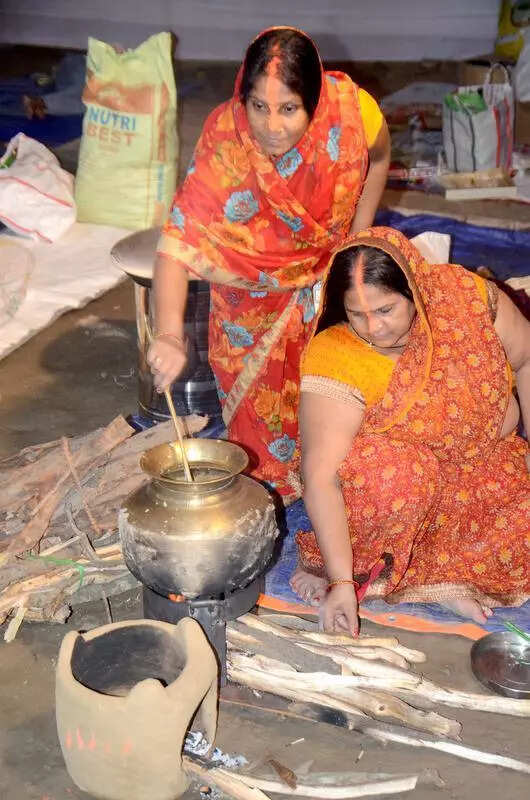Devotees Celebrate Kharna with Kheer and Roti as Chhath Festival Begins | Patna News – Times of India

Patna: Amid devotional songs and folk melodies dedicated to Chhathi Maiya, devotees across the state observed ‘Kharna’ on the second day of Chhath before beginning their 36-hour ‘nirjala vrat’ (fasting without water), which will conclude with morning ‘arghya’ (oblation to the rising sun) on November 8.
The ‘Kharna’ rituals started with the devotees taking holy dip in Ganga and other rivers across the state in the morning. In the evening, they performed a puja before having the ‘Kharna prasad’ of ‘kheer (rice pudding)-roti’, which was also distributed among family members and other visitors to their homes.
Before the holy dip early in the morning, the devotees cleaned their houses. After the holy dip, the vratis wore new clothes, before starting the austere ‘Kharna’ fast, maintaining complete abstinence, even from water, which continued till evening puja. During the puja at the time of sunset, the special ‘Kharna prasad’, comprising ‘kheer’, bananas and roti or puri, are offered to the setting sun and ‘Chhathi Maiya’.
“I made ‘kheer prasad’ in jaggery as sugar is considered impure. Before preparing the ‘prasad’, we also worship the earthen stove (chulha). Mango woods are used as fuel. After offering the prasad to ‘Chhathi Maiya’, I ate it and started the 36-hour fast,” said Anuja Shankar, a devotee.
The ‘kheer’ is prepared with cow milk, rice and jaggery.
For the roti, wheat has to be washed in holy Ganga water a day before on ‘Nahay-khay’ — though nowadays people clean it again using normal tap water after coming back home — and sun-dried. The wheat is ground in the morning of Kharna, for which people start thronging the neighbourhood flour mills barefoot.
The mills too cleaned their grinding machines beforehand. In the afternoon, devotees prepared the ‘Kharna prasad’ at homes and Chhath ghats.
It is believed that the ‘prasad’ purifies the body and gives strength to observe the 36-hour fast.
A large number of devotees also assembled at various Sun temples across the state, including Deo temple in Aurangabad, Aungari Dham in Nalanda and Handia Surya Mandir in Nawada district.
“The four-day Chhath puja holds deep meaning for its followers, extending beyond spiritual practises to encompass quality time with family members and heartfelt wishes for their welfare. Numerous women undertake fasting, seeking divine blessings for their children through dedicated prayers and ceremonial offerings,” said Yuvraj Srivastava, a ‘vrati’.
Another ‘vrati’, Chitra Singh, said that the Chhath festival also gives a strong message towards environmental consciousness.
“Worshippers congregate near water bodies for offering prayers. This emphasises the vital relationship between humans and nature, particularly highlighting the significance of the sun and other natural elements in our lives,” she said.
On the third day, November 7, the devotees will assemble at riverbanks, ponds and other water bodies, go inside knee-deep to offer ‘arghya’ to the setting Sun. They return to the same spots the next day and pray to the rising sun, marking the end of the four-day festival.
During the third day, the devotees make puja offerings like thekua, besides preparing the ‘soop’ (a kind of bamboo pan) with coconut, banana, other seasonal fruits, along with different puja paraphernalia. The ‘vrati’ holds the ‘soop’ for offering the evening and morning ‘arghya’ after taking a holy dip.
The ‘Kharna’ rituals started with the devotees taking holy dip in Ganga and other rivers across the state in the morning. In the evening, they performed a puja before having the ‘Kharna prasad’ of ‘kheer (rice pudding)-roti’, which was also distributed among family members and other visitors to their homes.
Before the holy dip early in the morning, the devotees cleaned their houses. After the holy dip, the vratis wore new clothes, before starting the austere ‘Kharna’ fast, maintaining complete abstinence, even from water, which continued till evening puja. During the puja at the time of sunset, the special ‘Kharna prasad’, comprising ‘kheer’, bananas and roti or puri, are offered to the setting sun and ‘Chhathi Maiya’.
“I made ‘kheer prasad’ in jaggery as sugar is considered impure. Before preparing the ‘prasad’, we also worship the earthen stove (chulha). Mango woods are used as fuel. After offering the prasad to ‘Chhathi Maiya’, I ate it and started the 36-hour fast,” said Anuja Shankar, a devotee.
The ‘kheer’ is prepared with cow milk, rice and jaggery.
For the roti, wheat has to be washed in holy Ganga water a day before on ‘Nahay-khay’ — though nowadays people clean it again using normal tap water after coming back home — and sun-dried. The wheat is ground in the morning of Kharna, for which people start thronging the neighbourhood flour mills barefoot.
The mills too cleaned their grinding machines beforehand. In the afternoon, devotees prepared the ‘Kharna prasad’ at homes and Chhath ghats.
It is believed that the ‘prasad’ purifies the body and gives strength to observe the 36-hour fast.
A large number of devotees also assembled at various Sun temples across the state, including Deo temple in Aurangabad, Aungari Dham in Nalanda and Handia Surya Mandir in Nawada district.
“The four-day Chhath puja holds deep meaning for its followers, extending beyond spiritual practises to encompass quality time with family members and heartfelt wishes for their welfare. Numerous women undertake fasting, seeking divine blessings for their children through dedicated prayers and ceremonial offerings,” said Yuvraj Srivastava, a ‘vrati’.
Another ‘vrati’, Chitra Singh, said that the Chhath festival also gives a strong message towards environmental consciousness.
“Worshippers congregate near water bodies for offering prayers. This emphasises the vital relationship between humans and nature, particularly highlighting the significance of the sun and other natural elements in our lives,” she said.
On the third day, November 7, the devotees will assemble at riverbanks, ponds and other water bodies, go inside knee-deep to offer ‘arghya’ to the setting Sun. They return to the same spots the next day and pray to the rising sun, marking the end of the four-day festival.
During the third day, the devotees make puja offerings like thekua, besides preparing the ‘soop’ (a kind of bamboo pan) with coconut, banana, other seasonal fruits, along with different puja paraphernalia. The ‘vrati’ holds the ‘soop’ for offering the evening and morning ‘arghya’ after taking a holy dip.
















